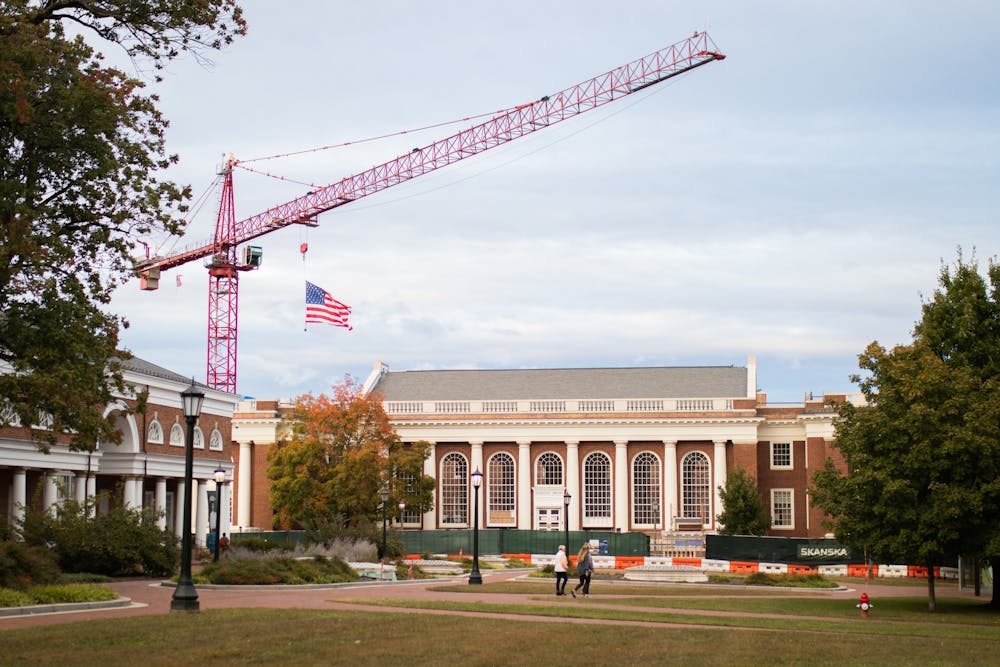The U.S. News and World Report released its new 2022-23 college rankings earlier this month. As high schoolers apply to and decide what college they will attend in the upcoming months, these rankings are likely of the utmost importance for many. Such rankings are also vitally important to University President Jim Ryan, who has set out many lofty goals in his 2030 strategic plan. Among them is his wish for the University to become the best public university by 2030. This will push the University further into the stratosphere of elite institutions, but the impact from expansion that students may face is not something to be ignored. Some of us may reap benefits in the end, but growing pains — like construction and disconnection — are a disruption to student life.
Construction comes with a hefty price tag and a financial burden that could negatively impact students. The strategic plan outlines an expansion of the University’s financial aid program — promising more aid to students with lower income — but it includes nothing about tuition for students who do not qualify for aid. While increased access is definitely a great move, how much will being No. 1 cost other students? With tuition largely being tied to how much funding the University receives from the state, what happens if the state reduces funding? Will tuition for out of state and graduate students increase? With estimated tuition coming in at over $35,000 for in-state students and more than double that for out-of-state students, a tuition hike will be a hard pill to swallow without tangible benefits. Those of us on Grounds today won’t be students in 2030 to reap the benefits of being No. 1, so current students are getting the short end of the stick with the disruptive construction and expansion.
We are expanding too much and doing it too fast. Selfishly, what good are resources if we can’t access them? Is the University delivering on its promise of “world class resources” if construction disrupts my walk around Grounds and I have to compete for a space to study in the library before the largest one reopens in the fall of 2023? The University has a responsibility and duty to improve itself for future students, but that doesn’t mean current students completely embrace all that is needed to become No. 1. Maybe I will appreciate the new buildings and resources as an alumnus, but right now all I feel is inconvenienced, disconnected and jealous of those students who will get to experience Grounds without so much construction.
It is no secret that the University prides itself on being one of the best institutions in the U.S. It broadcasts our No. 3 ranking among public institutions in bold numbers on the admissions website. A No. 1 ranking might provide benefits like more attractive resumes for students or prestigious connections and opportunities after graduation, but is first and foremost a marketing tactic. A No. 1 ranking will certainly attract more prospective students, driving down the acceptance rate. The University will have less leg work to do when getting prospective students to apply as students aim for an acceptance from the best public university in the country. New facilities will provide shiny places to learn and study. It is important to note that the rankings provided by U.S. News and World Report are not based on development, but place a heavy weight on things like retention rates, peer evaluation between universities and the amount of faculty with terminal degrees. Despite being disconnecting and disruptive to current students, construction and new development help the University attract all those things. Growth is necessary to remain a healthy, competitive institution, but in our quest for greatness, we must first examine ourselves as an institution.
The strategic plan promises to promote its values, with diversity being one of them. But can we really do that if we, as a community, are still experiencing hate crimes? The lackluster response from the University reveals a long way to go. Perhaps our goal should be to protect the marginalized students already here, rather than offer new students false hope. If we are going to be No. 1, the University should do so by fostering the community of students already here, rather than making promises of diversity and safety that it can’t keep to future students. The University administration must answer the demands of the student body before it worries about future students. While working to become “great and good” as the No. 1 public university and recognizing the demands of minority students are not mutually exclusive, perhaps the University should be pouring more resources into diversity efforts before students must demand them. The University needs to do a better job of focusing on diversity efforts in addition to all the other promises in Ryan’s quest to be “great and good.”
Growth, especially at an institution like the University, is inevitable. However, it is imperative that this growth does not come at the expense of current students. Construction is already taking over Grounds, tuition is high and the student body is unhappy with recent events on Grounds. The University has a duty to protect us as current students and should not ignore our needs in the quest to be “great and good.” The University must ask itself — what is being the best worth? Hopefully, the answer is not the welfare of current students.
Riley Lorgus is an Opinion Columnist who writes about administration and University life for The Cavalier Daily. He can be reached at opinion@cavalierdaily.com.
The opinions expressed in this column are not necessarily those of The Cavalier Daily. Columns represent the views of the authors alone.







